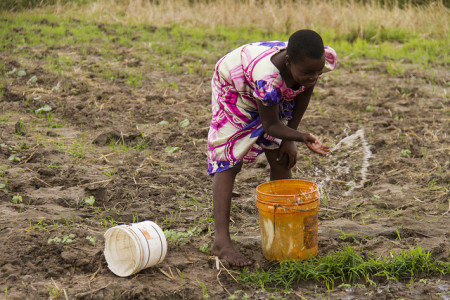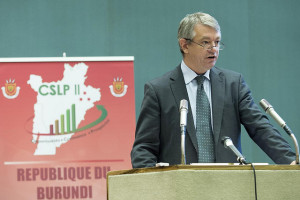By Jacob Kushner April 15, 2015

Splashing water on crops in Tanzania. ©WorldFish
Often, journalists conducting long-term investigative projects don’t contact the entity they’re investigating until the very end, when there’s less time for the subject to interfere with the reporting process. But a recent experience in which I did just the opposite showed me the enormous benefits that can come with engaging the target of your investigation and being transparent about the story you intend to write from the very start.
Last year, in a project for GroundTruth, Boston-based investigative journalist Tom Murphy and I set out to expose the failings of a $1.4 billion dollar water project in Tanzania, conceived and largely funded by the World Bank. One of the largest water projects in the world, its goals were ambitious: In a country where nearly half the population lacked access to water, it set out to bring improved water access to 65 percent of rural Tanzanians and 90 percent of urbanites by 2010, and to continue until each and every citizen had safe drinking water.
Our investigation got started when Murphy uncovered evidence that the project wasn’t working—that long after the 2010 deadline, millions of rural and urban Tanzanians still lacked access to water. We soon heard rumors that some of the water systems built in rural areas as part of the project were coming in late, over budget, and that in some cases they were breaking down just a few years after they were built.
Because we only had one month on the ground in Tanzania, our original plan was to try our best to locate failed water systems using the limited documentation and inside sources we had compiled so far. But it was a risk: These water projects were scattered across remote areas of the country. With only a few weeks to report, we’d run the risk of not finding anything at all.
And so, we did something that went against the instincts I’d learned as an investigative reporter: Rather than keep our investigation and our findings quiet until we had the story nearly wrapped up, we showed the Bank our hand, describing what we were up to and asking in return for a list of water systems that weren’t working.

Philippe Dongier, Representative of World Bank of Tanzania, Uganda and Burundi during the Conference for Burundi’s Development Partners. 29 october 2012. ©Jean-Marc Ferré, UN Geneva on Flickr
We started at the top by speaking with the World Bank’s Tanzania Country Director, Philippe Dongier. Surprisingly, Dongier was eager to discuss the project with me in detail. When I landed in Dar es Salaam last spring, he and his colleagues met with me immediately to discuss the project’s successes and setbacks.
Better yet, Dongier’s staff introduced me to some of Tanzania’s top government water officials, one of whom told me precisely what villages to go to in order to find water systems that were built under the project but that were no longer working or that otherwise exemplified the challenges of bringing water to Tanzania’s rural poor.
Opening the books on one of the largest water projects in the world to a team of investigative journalists was no doubt a risk for bank and Tanzanian officials. Indeed, our reporting revealed that their project was failing to meet any of its stated goals: “Coupled with Tanzania’s rising population, 3.5 million more Tanzanians lacked access to improved water than did before the project began,” our investigation found.
Dongier wasn’t happy with our report—while he admitted the project had gotten off to a slow start, he argued that things were beginning to turn the corner, with more and more water systems getting built each month. And yet, by engaging with us early, Dongier and his staff influenced the direction of our reporting and the content of the articles themselves. For example, because we were made aware early on of the Bank’s argument that the project was beginning to speed up, we devoted an entire article to examining that claim and the likely future of the project, which became the fourth and final installment of our series. Had we simply learned of that argument near the end, chances are it would have earned a paragraph or two in our story at most.
“Inclusion allowed for some more honest discussions from the get-go as opposed to a defensive stance with coming to questions late in the game,” said Murphy of our interaction with bank officials.
“For me it was also important for us to give them the benefit of the doubt from the start. By reaching out and going to the places they recommended, we gave them the chance to tell their own story, share their own data and show off their own projects,” Murphy says. “That made me feel more confident about our findings.”

Dar-es-Salaam, Tanzania © Rob
The World Bank’s willingness to engage us illustrates something important about how a target of a journalistic investigation may weigh the risks and benefits of opening its books to journalists: Some officials will decide it’s worse to receive a long list of questions and criticisms towards the end of an investigative project such as ours, than to engage in the process from the start, especially if this means they can get a commitment from reporters to consult them at every step of the process.
Indeed, giving your target subject a chance to respond from the beginning is often a more ethical way to report. Some reporters will spend weeks or months communicating with critics of a project and then spend just a day or two giving the critiqued a chance to rebut. If the subject of your investigation doesn’t want to engage with you, they won’t. But it’s often worth a shot: If they agree, you’re likely to get a more nuanced and powerful story out of it.
You can read the full GroundTruth investigative series here:
****
Jacob Kushner is an investigative journalist currently based in East/Central Africa and the Caribbean. He reports on development economics and inequality, foreign aid and investment, governance and innovation in developing nations. He investigates development aid and human rights abuses for GroundTruth. Read more at his website or follow him on Twitter.
This entry was posted on Wednesday, April 15th, 2015 at 1:03 pm. It is filed under Skills and Tradecraft and tagged with GroundTruth, Tanzania, water infrastructure, World Bank. You can follow any responses to this entry through the RSS 2.0 feed.
Comments are closed.
